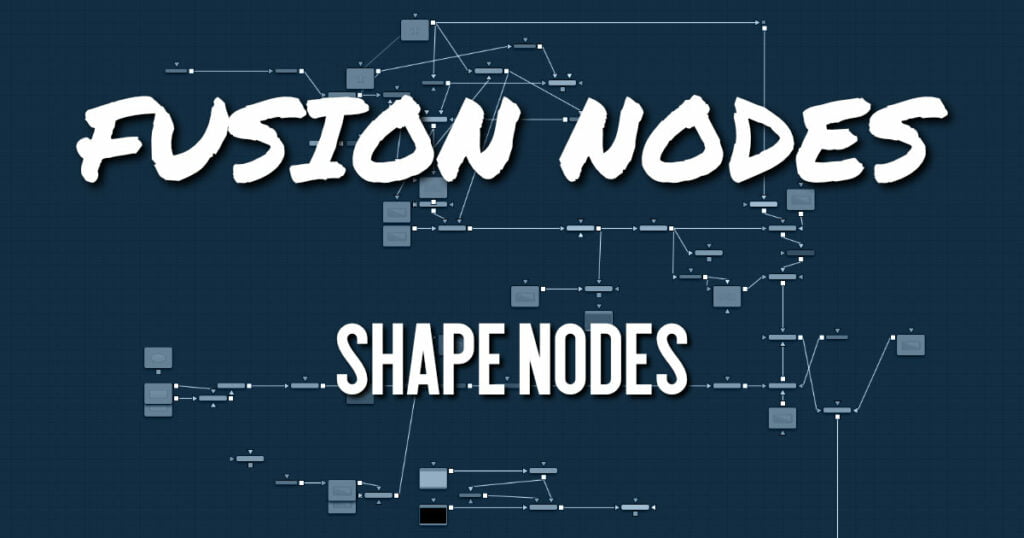Your cart is currently empty!
Shape Nodes

Shape Nodes
Nodes that handle Shape operations share a number of identical controls in the Inspector. This section describes controls that are common amongst Shape nodes.
ADVERTISEMENT
Shape Nodes Settings Tab
The Settings tab in the Inspector can be found on every Shape node. Most of the controls listed here are only found in the sRender node but a few are common to all Shape nodes.
Blend (sRender only)
The Blend control is used to blend between the tool’s original image input and the tool’s final modified output image. When the blend value is 0.0, the outgoing image is identical to the incoming. Normally, this causes the tool to skip processing entirely, copying the input straight to the output.
Process When Blend Is 0.0 (sRender only)
The tool is processed even when the input value is zero. This can be useful if processing of this node is scripted to trigger another task but the value of the node is set to 0.0.
Red/Green/Blue/Alpha Channel Selector (sRender only)
These four buttons are used to limit the effect of the tool to specified color channels. This filter is often applied after the tool has been processed.
For example, if the red button on a Blur tool is deselected, the blur is first applied to the image, then the red channel from the original input is copied back over the red channel of the result.
There are some exceptions, such as tools where deselecting these channels causes the tool to skip processing that channel entirely. Tools that do this generally possess a set of identical RGBA buttons on the Controls tab in the tool. In this case, the buttons in the Settings and the Control tabs are identical.
Apply Mask Inverted (sRender only)
Enabling the Apply Mask Inverted option inverts the complete mask channel for the tool. The mask channel is the combined result of all masks connected to or generated in a node.
Multiply By Mask (sRender only)
Selecting this option causes the RGB values of the masked image to be multiplied by the mask channel’s values. This causes all pixels of the image not included in the mask (i.e., set to 0) to become black/transparent.
Motion Blur (sRender only)
- Motion Blur: This toggles the rendering of motion blur on the tool. When this control is toggled on, the tool’s predicted motion is used to produce the motion blur caused by the virtual camera’s shutter. When the control is toggled off, no motion blur is created.
- Quality: Quality determines the number of samples used to create the blur. A quality setting of 2 causes Fusion to create two samples to either side of an object’s actual motion. Larger values produce smoother results but increase the render time.
- Shutter Angle: Shutter Angle controls the angle of the virtual shutter used to produce the motion blur effect. Larger angles create more blur but increase the render times. A value of 360 is the equivalent of having the shutter open for one whole frame exposure. Higher values are possible and can be used to create interesting effects.
- Center Bias: Center Bias modifies the position of the center of the motion blur. This allows for the creation of motion trail effects.
- Sample Spread: Adjusting this control modifies the weighting given to each sample. This affects the brightness of the samples.
Use GPU (sRender only)
The user GPU menu has three settings. Setting the menu to Disable turns off hard accelerated rendering using the graphics card in your computer. Auto uses a capable GPU if one is available and falls back to software rendering when a capable GPU is not available.
Hide Incoming Connections
Enabling this checkbox can hide connection lines from incoming nodes, making a node tree appear cleaner and easier to read. When enabled, empty fields for each input on a node will be displayed in the Inspector. Dragging a connected node from the node tree into the empty field will hide that incoming connection line as long as the node is not selected in the node tree.. When the node is selected in the node tree the line will reappear.
Comments
The Comments field is used to add notes to a tool. Click in the empty field and type the text. When a note is added to a tool, a small red square appears in the lower left corner of the node when the full tile is displayed or a small text bubble icon appears on the right when nodes are collapsed. To see the note in the Node Editor, hold the mouse pointer over the node to display the tooltip.
Scripts
Three Scripting fields are available on every tool in Fusion from the Settings tab. They each contain edit boxes used to add scripts that process when the tool is rendering. For more information on scripting nodes, see the Fusion scripting documentation.
ADVERTISEMENT










